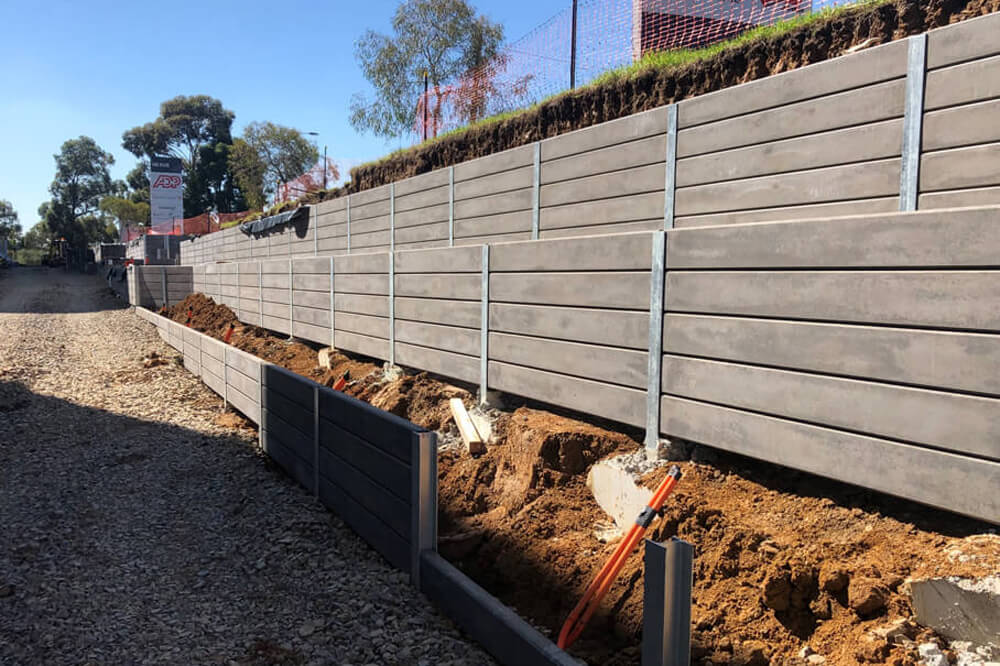Everything You Need to Know About Concrete Sleeper Retaining Walls

A retaining wall is a structure used to support a mass of soil laterally to sustain an otherwise unsustainable slope. For instance, if you want to widen your driveway and the area has slopes of soil nearby, a retaining wall pushes the soil up and away and gives more space for your driveway while supporting the new, steeper slope on either side.
Other projects where you might need a retaining wall may include:
- Landscaping and gardening, including for decorative purposes
- Flattening an area for a specific purpose and building retaining walls to define the space
- Building a basement
- Creating a multi-levelled terrace or structure
In each case, a retaining wall is needed to keep a wedge of soil from slipping at its natural slope. There are many different types of retaining walls, each adapted to its role. In this post, we will examine the characteristics of concrete sleeper walls in greater depth. These retaining walls are extremely strong and are built of concrete sleepers, just as their name suggests. The concrete is reinforced with steel, making them versatile and able to hold back large quantities of soil.
What Exactly Goes into a Concrete Sleeper Retaining Wall?
Concrete sleepers are one of the best types of retaining walls, as they can come in virtually any design without compromising their structural integrity and function. Concrete can be coloured and shaped in various styles, even resembling natural stone or moulded into minimalistic, modern designs. Additionally, concrete can be pigmented while being prepared, which avoids chipping or fading of the colours.
Concrete is a very strong material that can be poured into any shape, making the sleepers of these retaining walls strong enough to support wedges of soil up to 4 metres high. They are easy to install and can be engineered to serve any purpose, from building driveways to landscaping gardens or bordering roads and basements.
To make concrete sleeper retaining walls so strong, they are typically reinforced with steel rods. The steel rods are added to the walls to bond them together, offering a solid structure that distributes the weight of soil and water over a larger surface. For higher concrete sleeper walls, additional steel rods are used to give added support. In some cases, concrete sleeper walls don’t have steel reinforcements, but these are used for smaller-scale projects.
Sleepers come in various sizes and widths, depending on the project you want to use them for, such as building up a basement for your house or creating a foundation for a new garage. When undertaking more substantial construction like foundational work, retaining walls should be assessed and installed by professionals to ensure all safety regulations are met, environmental and soil conditions evaluated, and the retaining wall material chosen is adequate for the job.
Isn’t Concrete just Cement?
For many people, the terms concrete and cement are interchangeable. This isn’t true as there are differences between the two materials, differences that must be considered when using either for construction projects.
So, what is the difference between concrete and cement? The main difference is that cement is actually an ingredient of concrete. The latter also contains rocks, sand, crushed stones, or other aggregates bonded together by the cement paste. A concrete structure hardens over time as the cement and aggregates lock together while it dries.
Because concrete sleepers are designed to lock together in place, they don’t need mortar or other binding substances. Once the sleepers are fit together, they are strong enough to serve their purpose.
Another difference between concrete compared to cement is that concrete controls moisture without suffering from water damage. This makes them good for basement and garden retaining walls, and other projects where moisture is a challenge.
The fusing of concrete and cement creates an effective barrier, but this process requires precise calculations. Undertaking such a process yourself can be dangerous and cause wall failure later down the road leading to property damage, injury, and liability. As previously stated, consulting a retaining wall specialist to ensure the safe construction of your retaining wall is vitally important.
A Concrete Choice: Reasons to Choose a Concrete Sleeper Retaining Wall
Aside from the overall durability and strength of a concrete sleeper wall, they are versatile because they can be poured into various designs. This makes them a great fit for projects like landscaping and garden design. Additionally, things like pigments and decorative elements can be easily added to the sleepers to give them a more attractive look.
Thus, concrete sleeper retaining walls are a great choice for virtually any project you have in mind. Concrete is strong and versatile, enabling it to adapt to your design vision. Plus, it’s relatively easy to install as well.
When the Dust Settles
While concrete sleeper retaining walls are a great choice for retaining wall construction, constructing one requires the hand of an expert to ensure the mix of materials is precisely handled.
The expertise of an engineer or retaining wall specialist is invaluable in retaining wall construction projects to avoid dangerous consequences including:
- Wall failure – a situation where the retaining wall is unable to sustain the weight of the soil wedge behind it.
- Inadequate drainage – a situation where the wall does not allow water to drain away. One of the most common causes of retaining wall failures is the lack of proper water drainage. Water adds significant weight to soil and, if not redirected, may cause a retaining wall to fail.
- Improper engineering – walls that are not designed by an engineer can potentially fail, and detailed calculations and proper planning need to be done before building a retaining wall.
- Insufficient excavation – if not installed deep enough, the wall can collapse. Retaining walls that are not properly anchored in the ground will collapse, causing property damage, injury, and even death.
How TFR Construction Can Help With Your Construction Project
Choosing a contractor with decades of experience can help you ensure your retaining wall meets all your needs and specifications. Our team of experts here at TFR Construction is ready to bring your project to life. When you choose to work with us, you can rest assured that you will get a strong and reliable concrete retaining wall that will last for many years to come. Simply describe your construction plan, and we will take care of the rest. Get in touch with us today!
Recent Posts
A Parcel for the Picking – Things to Consider When Buying Land for Your Home
Selecting the proper parcel of land might be challenging but approaching the task with the correct knowledge makes it worthwhile.
Stone Landscaping: Adding Statement Stone and Boulders to Your Landscape
Stone landscaping is low maintenance, sustainable, and extremely versatile. Here is a realistic view of the main pros and cons of stone landscaping.
5 Ways to Beautify Your Sleeper Retaining Walls
In this blog post, we examine how you can combine looks and function with the latest designs of retaining walls available today.
How Sleeper Retaining Walls Can Help with Property Water Drainage Systems
We take a closer look at why retaining walls can be a fantastic solution for redirecting water around the house and protecting your foundation.
What Is a Commercial Contractor?
Contractors who work on commercial buildings have the know-how, expertise, and certifications to handle commercial construction work. But what exactly is a commercial contractor, and do you need one for your next project? Read on to find out if a commercial contractor is right for you.
Recent Posts
A Parcel for the Picking – Things to Consider When Buying Land for Your Home
Selecting the proper parcel of land might be challenging but approaching the task with the correct knowledge makes it worthwhile.
Stone Landscaping: Adding Statement Stone and Boulders to Your Landscape
Stone landscaping is low maintenance, sustainable, and extremely versatile. Here is a realistic view of the main pros and cons of stone landscaping.
5 Ways to Beautify Your Sleeper Retaining Walls
In this blog post, we examine how you can combine looks and function with the latest designs of retaining walls available today.
How Sleeper Retaining Walls Can Help with Property Water Drainage Systems
We take a closer look at why retaining walls can be a fantastic solution for redirecting water around the house and protecting your foundation.
What Is a Commercial Contractor?
Contractors who work on commercial buildings have the know-how, expertise, and certifications to handle commercial construction work. But what exactly is a commercial contractor, and do you need one for your next project? Read on to find out if a commercial contractor is right for you.





